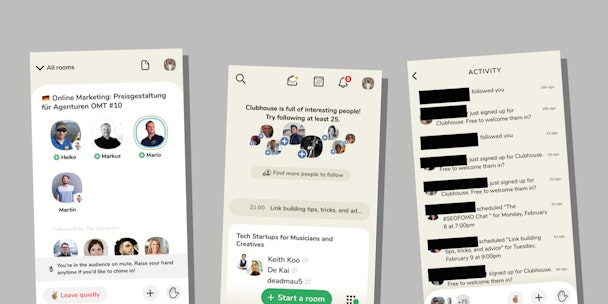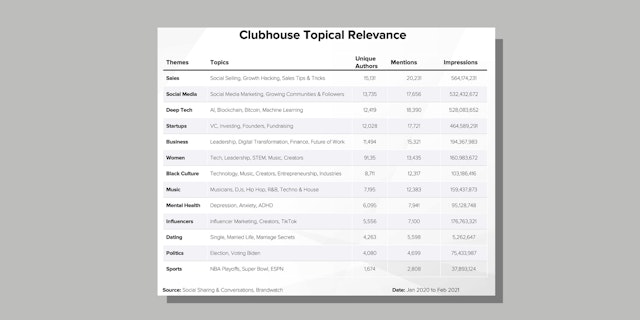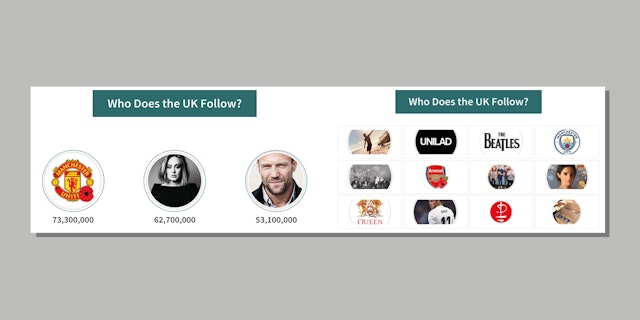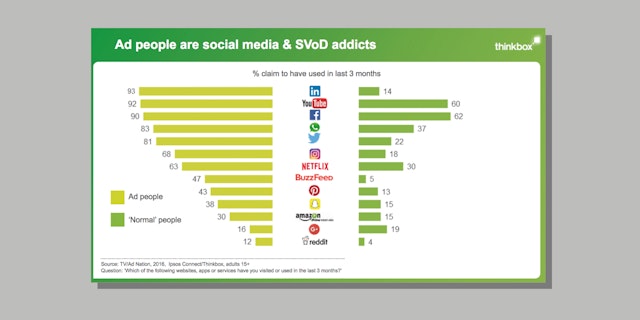The right and wrong ways that marketers can use Clubhouse
LinkedIn has many 25-year-old wannabe life coaches and motivational speakers who are inspired by Gary Vaynerchuk and masquerading as professional marketers. In this edition of The Promotion Fix, columnist Sam Scott wonders whether Clubhouse will be something similar.

“Clubhouse is basically a glorified facilitator of conference calls, radio shows and telephone party lines from the 1990s”
The internet’s graveyard is full of failed challenger social networks. Ello (goodbye). Gab (racists). Parler (fascists). Google+ (minus). Yik Yak (blah blah). Vine (died on the). Facebook, Instagram, Twitter, LinkedIn, Snapchat and TikTok remain dominant.
Now, enter the Clubhouse. According to Apptopia, the platform has been downloaded 4.7m times since its April 2020 launch – 3.7m (79%) of which have occurred in 2021 so far. The network also raised $100m in investment funding. Most significantly, Elon Musk and Mark Zuckerberg appeared on a Clubhouse talk show, further drawing attention to the app.
But how – if at all – should marketers use it?
What is Clubhouse?
First, a quick overview. Clubhouse is an invitation-only audio chat platform based on the use of public and private ‘rooms’. Anyone with an iPhone can sign up for the waiting list. People already using Clubhouse can approve their personal contacts in the queue to join. Thanks to a friend in the marketing industry, I now have the app.
Today, for example, I could create a public or private chat room for people who hate Morrissey. (Seriously, his singing voice and newfound racist views are repugnant.) Next, I could invite people I know who feel the same way or see who shows up. Then, we could all have a nice group chat about how much Morrissey sucks. Up to 5,000 people can be in a room.
Now, substitute any topic and any group of people you know. That is Clubhouse. Public rooms are listed in the app. Anyone can enter, and those who do so are pre-muted. Room hosts and moderators can speak as well as recognize anyone who has ‘raised their hand’. Private rooms, of course, require personal invitations.
Clubhouse is basically a glorified facilitator of conference calls, radio shows and telephone party lines from the 1990s. At the top of this page are some screenshots from the app on my iPhone.
Not surprisingly, Clubhouse has so far interested people mainly in the tech and marketing worlds – those who tend to be the earliest of early adopters. Zeno Analytics and Michael Brito posted an analysis this month of the most popular topics on the platform.

“Clubhouse is the LinkedIn newsfeed with audio,” a Twitter user named Ani joked. Also not surprisingly, Gary Vaynerchuk has appeared.
How marketers should and should not use Clubhouse
At a prior job, my boss talked all the time about hiring someone to “do social media”. I asked him to be more precise and explain what marcom tactic the person would do over that group of channels. Direct response? Brand advertising? PR? (After all, we never hire anyone to “do television”.) But he just shrugged off my question because he was still living in 2007.
That year, Facebook created pages for companies and organizations. Supposedly, a communications revolution was happening. Businesses could produce cheap material that would spread virally on Facebook and gain them followers for free. (Later, they could then use posts to sell something to those followers.) That was what my boss had in mind.
But by 2014, free ‘organic’ reach for pages had plummeted to just over 6%. Further declines were imminent. Companies had to pay to reach people – which is, you know, advertising. Yes, for a brief period of seven years, we did have a revolution. But that world has long since disappeared. Social networks are merely channels over which we can do traditional marcom tactics.
The difference between marcom channels and marcom tactics is important to understand. People are often experts at tactics, not channels. Good copywriters are generally able to write good copy for anywhere. But people who excel at direct response campaigns on Facebook, for example, are rarely able to do effective brand advertising there as well.
In that tactical context, it seems that Clubhouse right now could be effective mainly in PR and sales. Public relations staffers could create private rooms for purposes such as analyst calls, press briefings and community relations. B2B sales teams could create private rooms for discussions with all company stakeholders involved in approving expensive purchases.
But here is the problem. There are already countless ways to do conference calls. Google Hangouts. Skype. UberConference. Join.Me. GoToMeeting. Merged calls on iPhone and Android mobile devices. Slack. Zoom. Webex. The fucking[2] phone!
In the end, I see little that is different or special on Clubhouse – at least in a marcom context. People tout the app’s audio-only functionality, but PR and sales teams would prefer a platform that includes video so they can read everyone’s body language. (Clubhouse did not respond to a request for comment for this column.)
So-called ‘influencers’ could, in theory, also hype products to audiences in chat rooms, but influencer marketing is most effective in categories that are very visual such as fashion and cosmetics. Audio-only would not work.
In a corporate marcom context, Clubhouse might be most useful for internal communications – especially at large, global companies and ad agencies. Remote teams could meet and talk. All employees could join a private room to hear the CEO give an update. It would certainly be more interesting than an email – and no one could mistakenly hit ‘reply all’ to the entire company.
Stop obsessing over follower counts
Of course, the best business application is for so-called ‘content creators’ – basically anyone who releases anything informative or entertaining and has an audience – to use Clubhouse as yet another place to gain more followers. Many ad agencies and tech companies that are also still living in 2007 will want to do the same – even though it is largely pointless.
In 2019, I toured Europe with a B2B events company and delivered a series of keynote speeches on media planning. Each time, I researched the given country’s top Facebook pages and then looked for the top-ranking local consumer brand. As an example, here were the top 15 UK Facebook pages.

(Yes, it’s not an exact science. The Socialbakers data included ‘likes’ of UK pages from people outside the UK.)
The top-ranking UK Facebook page for a local consumer brand? The Cadbury Creme Egg at number 276. In country after country, I saw the same result. People follow mainly other human beings – celebrities, influencers, entertainers, politicians, bands and sports teams. Consumer brands were the last things that they cared to follow on social media.
Just remember this graphic based on objective data that Thinkbox compiled a few years ago.

Marketers are obsessed with media. The vast majority of non-marketing people are not. It’s why marketers immediately proclaim any new channel as the ‘next big thing’ – see Clubhouse – when the odds state that it most likely is not.
Yes, if you are selling something to the marketing or tech industries or are a bonafide famous person, then Clubhouse might be a good channel. But for everyone else, it is probably not – at least not yet.
But I predict that we will still hear many marketing people say without evidence that brands should be on Clubhouse and gain followers by ‘creating content’. Because follower counts are so important to consider when deciding what pizza to order and which B2B software platform to purchase. (Sarcasm.)[3]
In January 2021, many people noticed a decline in Twitter follower counts after the company deleted more fake bot accounts. CNN anchor Jake Tapper tweeted: “I would tell you how many followers I have lost, but I have no idea how many I had before because I’m an adult.”
The big picture surrounding Clubhouse
Snapchat unveiled the Stories media format in 2013. Instagram did it in 2016. Facebook, 2017. Even LinkedIn – the supposedly serious social network – released the feature in 2020. These companies didn’t even bother to change the name.
Copying the competition is Clubhouse’s biggest threat. Twitter is testing its own version. Facebook is reportedly working on one. Many new tech companies also simply copy the marketing strategies of the existing category leaders because they think having a superior product is all that matters. Contrary to popular mythology, Silicon Valley is not very creative.
Clubhouse’s biggest opportunity is the public’s return to mass media. The still-living-in-2007 crowd believes that mass, one-to-many media is obsolete. Well, look at the media consumption in 2020: shared TV watching in the UK was up and smartphone use in America was down. Podcasts are the new blogs – everyone has one, and most are not very good. Passive consumption has become trendy because it is less mentally exhausting at a stressful time.
I can sit back and listen to my Spotify playlists or the new British cable channel MTV 80s on my Israeli satellite network TV while I work. Or I can put on a podcast. And that is all. I do not need to worry about ‘engaging’ with anything. There are no comments, no ‘likes’, no shares, no inbox messages and no notifications.
My prediction for Clubhouse
Here is another prediction that is certainly not based on the past behaviors of any other social networks at all. At all.
Clubhouse will slowly open to more and more people and encourage them to sign up, create rooms and participate in other rooms. Later, the platform will create business accounts with added functionalities. Then, Clubhouse will create an ad network that businesses can use to promote their rooms.
The app will also create an algorithm that will feature the public business rooms that have the most engagement – those with the most attendees and most people asking questions. Marketers will then try to game the algorithm and thereby worsen the entire experience.
In a big shock that absolutely no one could have seen coming, Clubhouse will then no longer list public business rooms on the app and encourage them to buy advertising instead. The app will claim that the reason is that there are now too many public business rooms to list. Private rooms with more than a certain number of people will have to pay a recurring monthly fee.
And then Clubhouse will discover that private rooms are potentially the greatest generators of revenue for one simple reason: privacy means exclusion, exclusion creates desire and desire increases value.
Just think about how much VIP backstage passes to Pearl Jam concerts must have cost in the early 90s. Now, apply the same idea to the private rooms of celebrities on Clubhouse that I am sure will be on the way.
Say that Barack Obama will give an exclusive, private chat on Clubhouse. How much could he charge for a ticket? How much more could he charge for letting a listener ask a question? And what cut could Clubhouse receive? Even money says this is the company’s goal. But I still think people would rather watch Obama on video.
Still, with all of Clubhouse’s well-funded backers, the app might succeed. I just hope it doesn’t give Morrissey his own show.
The Promotion Fix is an exclusive column for The Drum contributed by global keynote and virtual marketing speaker Samuel Scott, a former journalist, newspaper editor and director of marketing in the high-tech industry. Follow him on Twitter. Scott is based out of Tel Aviv, Israel

